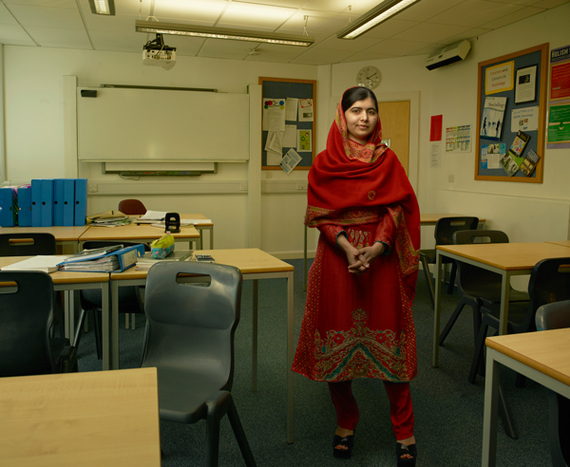What does a 21st century hero look like?
That's the question that's been haunting me ever since seeing Annie Leibovitz's WOMEN: New Portraits.

© Annie Leibovitz. From WOMEN: New Portraits
For most of recorded history, we've exalted iron-fisted leaders, warriors, and vigilantes as heroes. We've celebrated massacres, maniacal visions, and the domination of everything: people, animals, nature, societies. Too often, our only image of the hero is the man who dares to venture into the unknown, and then conquer what he finds.
Whatever mythological utility this hero may have had for early humans is outdated by millennia. Today's threats are murky, moving targets, so we need heroes who are strategic and nimble, whose options aren't just blowing up shit and pounding their enemies into submission. We need heroes who build bridges, not firebombs. The 21st century hero must have the power to transform societies, not destroy them.
Sometimes, this hero is a woman.
* * * * * *
The photographs in WOMEN: New Portraits -- a 10-city traveling exhibition commissioned by UBS, currently on view at San Francisco's Crissy Field -- have roots in a conversation Annie Leibovitz had in the 1990s with her longtime friend Susan Sontag. It was Sontag who suggested Leibovitz dive into women as subject matter, and at first, Leibovitz was hesitant. The enormity of the endeavor was like "trying to photograph the ocean." Where would a person even begin? But thankfully, she accepted the challenge, resulting in the collaborative book Women, published with Sontag in 2000.
The camera, more often than not, consumes the identities of women and regurgitates them as a topography of sexualized features. But as Leibovitz leaned into women as subjects, she began to push beyond the hyper-stylized poses and hard sheen that characterized her early work toward something more human and vulnerable. Her photographs became more relaxed -- less about a Leibovitz "signature look" and more about revealing the nuance of real personalities.
The current exhibition explores this humanness even further, and it extends to the installation choices. Rather than hung on white museum walls as a perfectly airbrushed 7 ft framed image, each photograph is torso-sized, resting on lines of brown twine held up by push pins in an old airfield hangar.
At first I was confused by the casual, almost awkward display. Accustomed to the high polish of gallery and museum exhibitions, I initially felt I had stumbled upon the work a little too early, as though it wasn't quite ready for public display. But gradually, "not ready" began to feel more real, more intimate, and flexible.
During the exhibit's first few days, I saw Leibowitz emerging from some other room with slightly different prints of the photos. She'd stand back to compare them side by side, and then sometimes switch them out. It was like being in her studio with works in progress. It was charming. What could be more human than the acknowledgement that even in their photographic form, these portraits were not just objects on public display, but living works in progress?
* * * * * *
There is an unapologetic and confident feminism in the work, underscored by Gloria Steinem's introduction reminding us that
"
history books rarely begin when humans did....[but] with male gods giving men dominion over women and nature, millions of women healer being burned as 'witches' because they taught contraception, racism that justified colonialism, and romance languages that attributed gender even to table and chairs
.
I even overheard some gallery-goers at the opening note with satisfaction that many of the women weren't smiling, an insider feminist rejection to the maddening, ubiquitous demand that women "smile more."
But what I noticed far more was the expressiveness in each of these women's eyes. The photographer's compassion comes through; the woman behind the camera gives her subjects the space to be real. There are no blank stares; no infantilizing coquettishness or fashion poses. A few are alert and inquisitive, but many more share a disarming tinge of weariness, a refreshing honesty revealed in the captured moment.
A I stood in front of the portraits, what struck me was not only the personal resonance of that feeling, but also relief to see the weariness in their eyes. It was ok to be tired.
And these women earned that right. Because no one said that being a hero in any era was easy. From Shonda Rhimes to Sheryl Sandberg, Gloria Steinem to Malala Yousafzai, these women have demonstrated relentless courage against the perpetrators of sexism, racism, and violence, and then turned around with generosity of spirit to make sure others were there with them to join in the movements they've started.
* * * * * *
If you're in San Francisco (or New York when the show heads there next), don't miss your chance to see the portraits of these 21st century heroes. Go when you've had a sh*tty day at your tech job in the heart of Silicon Valley, or when your eyes are weary of all the shows with all those male protagonists and filler ladies with unnecessary cleavage. Go when you're weary of working so hard to have your voice heard and your perspective acknowledged. Go when you know that you haven't been heard. Go with your daughter or niece to read the names of these women aloud and learn their stories. Then go a second time.
Go to remember that the heroism of women is not only possible, but happens every day.
Women: New Portraits is a free exhibition at The Presidio's Crissy Field, San Francisco, 25 March - 17 April. In each city, new portraits will added; this work will be part of the UBS permanent collection at the end of the tour.